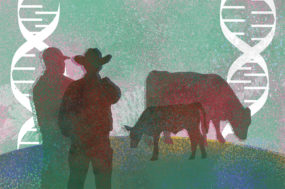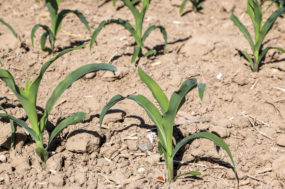Nationwide, the price of live cattle, or cattle ready for slaughter, has soared to a record $1.26 per pound, up 20 percent from a year ago. Prices are expected to rise even higher during 2012.
Experts point to two reasons for the big increase:
• U.S. beef exports are extremely strong. Through October, with two months in 2011 still ahead, U.S. beef exports totaled a new annual record of $4.49 billion, according to the U.S. Meat Export Federation. Mexico, Canada, Japan, South Korea and Russia all are buying much more beef. The weak U.S. dollar makes American beef more affordable to foreign consumers, says Tim Petry, livestock economist for the North Dakota State University Extension Service.
• U.S. cattle numbers continue to shrink, reducing the supply of beef. On Jan. 1, the United States had 90.8 million cattle and calves, down from 92.7 million on Jan. 1, 2011, and the lowest Jan. 1 inventory since 1952, when 88.1 million head were recorded.
Drought in Texas and surrounding states gets most of the blame. Many ranchers there, short of grass and hay, were forced to sell cattle.
To put the cattle numbers in better perspective, consider that the United States had 157 million people in 1952. Today, it has about 311 million. So the U.S. population has doubled in the past 60 years, while the number of cattle in the country is roughly the same.
The U.S. beef industry has become more efficient the past six decades, allowing more beef to be produced from the same number of cattle, Petry says. Even so, beef supplies are tight, causing the market to push up both cattle and beef prices, he says.
Retail U.S. beef prices reached a record $4.57 per pound in mid-December, up from $4.11 a year earlier, according to the most recent data from the U.S. Department of Agriculture.
Rising cattle and beef prices come against the backdrop of the weak U.S. economy and years of declining U.S. beef consumption. Despite the weak economy, many Americans still want beef and can afford it, although some may switch to cheaper cuts, Petry says.
Americans on average ate an estimated 57.5 pounds of beef per person in 2011, down from 59.6 pounds per person in 2010, according to the Livestock Marketing Information Center. Americans ate less beef per person last year than in any year since records began being kept in the early 1950s, the center says. Americans' per-capita consumption reached a record 94.3 pounds in 1976, when beef supplies were at record highs.
There's a strong connection between beef supplies and consumption of beef, Petry and others say, and per capita beef consumption won't rise until and unless beef supplies increase.
Increasing beef supplies would help to protect beef's market share against competition from other meat, cattle industry officials say.
Strong beef prices will encourage cattle producers to increase their herds. But that's not going to happen overnight, experts say.
When prices are high, some producers hold back female calves from the market. Eventually, the calves become cows and have calves of their own that producers sell. However, it takes several years for the calves to grow up, be bred, give birth and have their calves reach slaughter weight.
And while producers in drought-stricken areas want to build up their herds, they lack the pasture and hay to do so, Petry says.
"Weather will be a wild card" in determining when and how fast U.S. cattle numbers rise, he says.
Another factor is at work, too, says Dale Lueck, an Aitkin, Minn., cattleman and a spokesman for the Minnesota State Cattlemen's Association.
Crop prices are strong, so farmers are more likely to plant crops on some land once used for pasture or hay. With less grass and hay available, cattle producers have less ability to increase their herds, Lueck says.
Many cattle producers nationwide were breaking even or even losing money as recently as 2009, according to industry officials. Both declining demand and the high price of corn, a major feed source for cattle, were working against cattle prices.
Given recent difficulties, "It's time" that cattle producers enjoy some prosperity, says Kim Baker, a Hot Springs, Mont., cow-calf operator and president of the Montana Cattleman's Association.
One of the biggest questions is whether cattle prices will stay high enough long enough to attract more young adults into the business, she says.
"We need more young people," she says.
Even with the current high prices, getting started in cattle is very difficult without help from someone already in the business, she says.
Lueck says he thinks strong prices will encourage more young cattle producers to enter the industry, though "it's hard to say how much," he says.
Baker, who's spent 20 years in ranching, says she's skeptical that cattle prices will remain strong for long. Keith Johnson figures that cattle producers' profits will get squeezed as expenses rise.
"A lot of things (expenses) haven't gone up yet. They will. The higher that cattle get, everybody will want a piece of the action," he says.
Johnson, who is active in several cattle organizations, says he's a little concerned about how beef prices have climbed.
"One of my fears is that we can get too expensive. Right now, the only thing propping up these prices dramatically is that we are short of numbers," he says.
Even so, "We still have the cheapest supply (of beef compared with other countries). We have a good value," he says.
Johnson is enjoying the record cattle prices and the generally mild weather, and preparing himself for another grueling calving season.
And what would he say to consumers about high beef and cattle prices?
"I'd tell them the time has come. (Raising cattle) is a lot of hard work, and there have been a lot of years we just didn't make much money," he says.
—AP newswire report
PHOTO
Nationwide, the price of live cattle, or cattle ready for slaughter, has soared to a record $1.26 per pound, up 20 percent from a year ago. Prices are expected to rise even higher during 2012. Staff photo.








